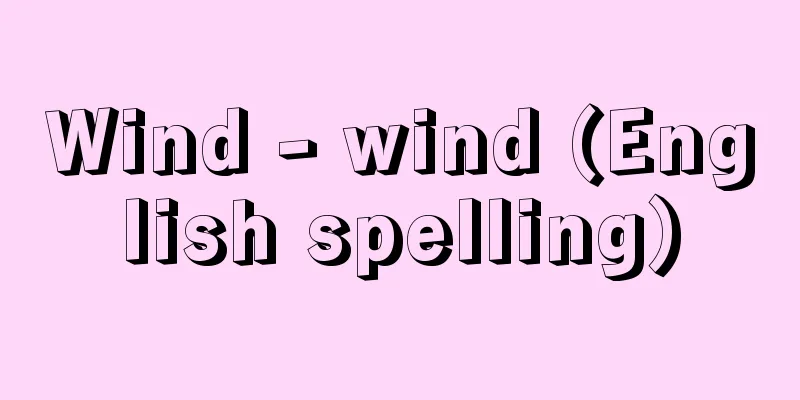Wind - wind (English spelling)

|
Generally, it refers to the movement of air on Earth, but the flow of electrically charged particles emitted from the Sun is called solar wind, and the movement of the atmospheres of other planets is also called wind. The character for wind is composed of the characters for "bon" and "mushi," and "bon" is said to indicate the pronunciation of the character for wind, with wind originally being pronounced "bon" or "han." This is a sound similar to the "v" and "w" in the French word "vent" and the English word "wind," and both are considered onomatopoeia that mimic the vibration of air. As can be seen from the fact that Japan's wind gods are male and female, Shinatsuhiko-no-Mikoto and Shinatobe-no-Mikoto (Nihon Shoki), the archaic word for wind was "shi" or "chi," and examples such as "kochi" (east wind), "arashi" (storm), and "nishi" (west wind) are also considered onomatopoeia. The English word wind has the same origin as weather, and as can be seen from the example of weather side, the two were used interchangeably in the past. The fact that a certain wind direction is accompanied by a certain weather has been recognized since ancient Greek times. [Junkichi Nemoto and Takashi Aoki] The Science of WindWind direction and speedWinds blow almost horizontally across the earth's surface, except in special cases such as when they cross mountains or in developed cumulonimbus clouds. Normally, the vertical movement is only about 1% of the horizontal movement, but this small vertical component of the wind is extremely important because it is this small component that causes various weather phenomena. Wind is a vector quantity with both direction and magnitude, so it is generally expressed by two components: wind direction and wind speed. Theoretically, it is expressed as an east-west component (u, west winds are + (plus) and east winds are - (minus)), a north-south component (v, south winds are + and north winds are -), and a vertical component (w, upwards is + and downwards is -). The commonly used wind directions are the 16 cardinal directions, but when specifying wind direction in more detail, they are expressed as angles of up to 360 degrees from north to east. In the past, east-west was the standard for this display, so it was said that the wind was from the northeast or southwest. However, now that north-south is the standard for global navigation, the winds are said to be from the northeast or southwest, and the 16 cardinal directions are also expressed in this way. As a very basic note, for example, a southerly wind is a wind that blows from south to north, not from north to south. Wind speed is usually expressed in meters per second, but in aviation and navigation, miles and knots are used internationally as units due to long-standing custom. The conversion between these units is as follows: 1m/s (second) = 1.944kt (knots) Wind power is sometimes expressed as a scale instead of wind speed (e.g., on weather charts). For extremely strong winds such as tornadoes, Tetsuya Fujita (1920-1998) devised the F-scale (the Fujita scale for expressing the wind speed of a tornado). [Junkichi Nemoto and Takashi Aoki] Wind ObservationMeteorological observatories and AMeDAS use propeller-type anemometers for wind observation, but until 1960, four-cup Robinson anemometers were used, after which they were replaced by three-cup anemometers with better characteristics, and in 1975 the current anemometers were used. Other anemometers include pressure anemometers that use wind pressure, hot-wire anemometers that use the change in electrical resistance of a hot wire depending on the wind speed, hot-film anemometers, the Bordeaux anemometer that uses the relationship in which the frequency of vortices formed behind an obstacle is proportional to the wind speed, ultrasonic anemometers that use the propagation speed of sound waves, and optical anemometers that use the movement of scintillation patterns of light. Remote sensing is also used to observe winds over the ocean, using microwave scatterometers mounted on artificial satellites to measure the reflection of radio waves from the sea surface. As described above, wind measurement has made great strides by using various methods, but on the other hand, wind observation can be performed outdoors without using machines to get a rough idea of the wind direction. If you hold a finger wet with water or saliva upright and rotate it two or three times while keeping the finger upright, the direction from which the wind is blowing will feel cold, and you can determine the wind direction. You can also get an idea of the wind inside a room from the way the smoke from cigarettes or incense flutters, or the way a candle flame flutters. Birds often perch facing the wind. The flight of insects, pollen, seeds, etc. is also controlled by the wind, so by observing these, you can learn the actual state of the wind. In spring, skylarks fly high into the sky facing the wind, and the weaker the wind, the more they flap their wings, so you can get a rough idea of the wind direction and speed. In places where winds predominate from a certain direction, the trees grow in a distorted manner, becoming irregularly shaped trees. It is known that the branches of soft trees such as persimmons will sway in the direction of the wind around May when new buds appear, and this can be used to get a rough idea of the wind conditions in the climate. Winds in the upper atmosphere can be roughly estimated from smoke flow at low altitudes and cloud movement at high altitudes, but quantitative observations are made by launching balloons filled with hydrogen or helium and tracking them with radar. Doppler radars, which can observe the movement of raindrops and snowflakes, are used to monitor upper-level winds, wind shear (a type of turbulence in which the wind direction changes horizontally or vertically or the wind speed changes suddenly), and downbursts (a phenomenon in which strong downward currents caused by cumulus clouds cause gusts of wind). Wind profilers, which observe upper-level wind direction and speed from radio waves sent from the ground that are reflected and scattered by the air and returned, are also in practical use. [Junkichi Nemoto and Takashi Aoki] Nature of WindThe wind has the following properties: [1] When wind hits an object, it exerts wind pressure. The units of wind pressure are wind speed V in meters per second (m/s) and wind pressure P in kg/ m2 per square meter. [2] The direction and speed of winds blowing over the earth's surface are constantly changing. When observed records are examined, there are two types of changes: (1) irregular changes that occur over a period of a few seconds, and (2) changes over a period of 100 to 10 hours (changes over a period of an hour are extremely rare). From this, it is clear that there are two types of wind changes, of which (1) is called a "wind breath." The magnitude G of a wind breath during a certain period is G = ( M - m )/( M + m ) where M is the maximum instantaneous wind speed observed during that period and m is the minimum instantaneous wind speed. [3] There is a roughly constant relationship between wind and air pressure. This relationship can be used to estimate the distribution of wind from the distribution of air pressure, which is why isobars are drawn on weather charts. In the Northern Hemisphere, when you stand with your back to the wind, the air pressure is lower than the ground surface to the left of that point and higher to the right, and this relationship is reversed in the Southern Hemisphere. Also, the closer the intervals between isobars, the faster the wind blows there. If we further summarize this in terms of pressure distribution, in the Northern Hemisphere, wind blows counterclockwise toward low pressure and clockwise away from high pressure. Again, in this case, the situation is reversed in the Southern Hemisphere. This empirical rule about the relationship between wind and air pressure is called the "Boys-Ballot Law" after the Dutchman Boys Ballot, who put it together in 1867. The relationship between wind and atmospheric pressure is simple in the case of upper-level winds, since there is no need to consider the frictional force acting between the wind and the earth's surface. In other words, in the case of large-scale westerly winds, upper-level winds blow almost parallel to the isobars of the upper level, with lower atmospheric pressure to the left in the Northern Hemisphere. As with surface winds, the wind speed is faster the closer the isobars are (the greater the pressure gradient), and the wind blows with a magnitude inversely proportional to the sine of the latitude of that point (sine, latitude). This type of wind blows when the pressure gradient force is in balance with the turning force of the Earth's rotation, and is called a geostrophic wind. The majority of upper-level winds can be considered to be geostrophic winds. [4] Wind speed generally increases with height. Wind weakens near the ground due to friction with the ground. Wind speed distribution from the ground surface to a height of about a few tens of meters increases roughly in proportion to the logarithm of height. Anemometers installed on the ground surface are usually installed at a height of 5 to 10 meters, and the wind speed at this height is thought to be about one-third (two-thirds at sea) of the wind speed at a height of several kilometers above the ground, where there is no ground friction. The wind speed distribution from 100 meters above ground to about 2000 meters is as shown in . The shape of the vertical distribution depends on the stability of the atmosphere (unstable when vertical convection is likely to occur, stable when it is unlikely to occur), and will vary as shown in the figure. In other words, when the atmosphere is unstable, the upper and lower air layers mix well, so the wind speed increases near the ground surface, and conversely, decreases above 300 meters. When the atmosphere is stable, there is no exchange of momentum between the upper and lower air layers, so the wind is weak below 500 meters, but the wind speed increases suddenly above that level. [5] In general, wind speed increases when it converges and decreases when it diverges. This effect is the reason why wind speed increases when it goes over a mountain or when air currents gather in a valley. [Junkichi Nemoto and Takashi Aoki] Causes of windThe primary cause of wind is the pressure gradient force, which occurs due to differences in atmospheric pressure depending on the location. When air starts to move from areas of high pressure to areas of low pressure due to this force, the following forces also come into play: (1) Frictional force acting on the ground surface and between air layers with different wind speeds. (2) Because the Earth rotates, the direction of a certain place changes from moment to moment, but if we consider the Earth to be stationary, we can discuss this as an object being subjected to a force perpendicular to its direction of motion. This force is called the "Coriolis force," and in the case of wind, the Coriolis force is dominant in large-scale wind systems. (3) When an isobar is curved, an acceleration proportional to the curvature is generated, and a corresponding force acts. This effect is particularly noticeable in wind systems such as typhoons. When the four forces above are in balance, the wind blows from areas of high pressure to areas of low pressure, maintaining a certain angle with the isobars on the surface. The inclination of the wind and the isobars is about 30 degrees on land and about 10 degrees over the sea. In the sky, there is almost no friction, so the wind blows parallel to the isobars. [Junkichi Nemoto and Takashi Aoki] Vertical windIn large-scale wind systems, the vertical wind speed is only about one-hundredth of the horizontal speed. This is called the dominance of horizontal motion. Although vertical winds (air currents) are very small, they play an extremely important role in the distribution and change of weather, such as the formation of clouds by updrafts and the continued clear skies in downdraft areas within high pressure zones. There are five causes of vertical air currents: (1) When wind blows over an obstacle such as a mountain, (2) when the surface of the earth is heated or when cold air flows into the upper atmosphere, (3) when winds converge or diverge, (4) when air currents rise along a front, and (5) in large-scale wind systems such as the westerlies, for example, air currents on the east side of a trough become updrafts and on the west side become downdrafts. For this reason, it is often cloudy and rainy on the east side of a trough, and sunny on the west side. [Junkichi Nemoto and Takashi Aoki] Wind systems on EarthThere are various scales of wind systems on the earth, ranging from large-scale global systems to small-scale systems such as indoor air currents, and these systems overlap. The main wind systems are as follows: [1] Small-scale wind systems: Indoor breezes, drafts through gaps, stage winds, forest winds, etc. These are thought to be related to minute temperature differences and friction on the ground's surface. [2] Mesoscale wind systems In addition to convection (cumulonimbus clouds and cumulonimbus clouds) and gravity waves (mountain waves), these include (1) land and sea breezes that develop in coastal regions, (2) mountain-valley winds in mountainous areas, (3) local winds such as downwinds, gusts, and föhn winds, and (4) tornadoes, tornadoes, downbursts, and other strong localized vortexes. [3] Large-scale wind systems The wind systems in the global troposphere are divided into (1) the Rossby circulation, which occurs approximately north of 30 degrees north latitude (or south of 30 degrees south latitude), and (2) the Hadley circulation, which is found closer to the equator than these latitudes. Of these, (1) the Rossby circulation is known as the mid- to high-latitude westerlies, a meandering westerly circulation that circles the poles. The strong wind belt seen in the westerlies is the jet stream, and there are two types of jet stream: the polar front jet stream, which is seen as an integral structure with the polar front, and the subtropical jet stream, which is a relatively steady stream to the north of the subtropical high. Easterly winds blow at low levels in the polar regions, and are called the polar easterly winds. (2) The trade winds (or equatorial winds) are seen in the lower level of the Hadley circulation, and they blow northeasterly in the Northern Hemisphere and southeasterly in the Southern Hemisphere. The large-scale wind systems, the Rossby and Hadley circulations, are superimposed on smaller-scale disturbances, such as (3) the monsoon circulation and (4) the tropical cyclones (typhoons), extratropical cyclones, and migratory highs that are familiar from everyday weather charts. A major difference between medium-scale and large-scale wind systems is that in the former, the influence of the turning force due to the Earth's rotation (Coriolis force) can be almost ignored, while in the latter, the influence of the turning force is overwhelmingly large. [Junkichi Nemoto and Takashi Aoki] Wind speed extremes and mean wind distributionThe highest wind speed ever recorded in Japan was 69.8 meters per second (west-southwest) recorded at Cape Muroto in Shikoku during Typhoon No. 23 on September 10, 1965. The highest instantaneous wind speed was 85.3 meters per second (northeast) recorded at Miyakojima in the Sakishima Islands on September 5, 1966. The highest maximum wind speed recorded on a mountain was 72.5 meters per second (west) recorded at the summit of Mt. Fuji on April 5, 1942, and the highest maximum instantaneous wind speed was 91.0 meters per second recorded on September 23, 1966, also at the summit of Mt. Fuji. The maximum wind speed recorded abroad was about 113 meters per second, observed on April 10, 1996, on Barrow Island in Western Australia. The strongest wind zone in the world is near the west of King George Island, east of Adélie Land around Antarctica, and the records recorded by a French expedition in 1951 were as follows: (1) 122 days with an average wind speed of 33 meters per second or more, (2) 22 days with an average wind speed of 14 meters per second or less, (3) the maximum 24-hour average wind speed was 48 meters per second, observed on March 21-22, 1951, (4) the maximum monthly average wind speed was 29 meters per second in March, (5) the annual average wind speed was 18 meters per second, etc. The wind direction was mostly east-southeast or south-southeast, and was a katabatic wind (downslope wind) blowing down from the inland ice cap toward the coast. Because of the turning force caused by the Earth's rotation, winds are much weaker in polar regions than in low latitude regions at the same pressure gradient. For example, even with the same pressure gradient in the Arctic, winds blow only about half the speed of those near Japan. Furthermore, fronts do not pass through the Arctic air masses as frequently as they do near Japan, so strong winds that would hinder exploration rarely occur. However, around Antarctica, cold air blows down from the inland ice cap as katabatic winds, making the winds stronger. Conversely, the pressure gradient in equatorial regions is very gentle, and therefore there are fewer isobars, but unlike the Arctic, winds tend to blow even with a small pressure gradient. The land and sea breezes that develop on the coast in winter and the lake breezes that blow around lakes and ponds are surprisingly strong in low latitude regions, sometimes exceeding 10 meters per second at their strongest. The average wind conditions across the globe vary from season to season, especially in the Northern Hemisphere, due to the seasonal wind circulation. The main characteristics are as follows: (1) Near the equator, there are easterly winds (trade winds) that blow from both the northern and southern hemispheres, but the point where the two air currents converge is biased toward the northern hemisphere in summer and toward the southern hemisphere in winter. The southeasterly trade winds that cross the equator in summer change direction and become southwesterly air currents in the northern hemisphere. (2) In the subtropics, powerful high pressure belts run from east to west, and winds blow from these belts in a clockwise direction in the Northern Hemisphere and a counterclockwise direction in the Southern Hemisphere. The subtropical high pressure belts also move north or south depending on the season. (3) In winter, air flows out from the high pressure system in the Eurasian continent, but in summer, the winds blow into the hot inland areas (seasonal wind circulation). (4) In the Northern Hemisphere, there are consistently low pressure areas over the Aleutian Islands, Iceland, and Greenland, and air currents blow into these areas. These low pressure areas tend to develop particularly easily in winter, and become part of the atmospheric pressure pattern, sending in the winter seasonal winds. [Junkichi Nemoto and Takashi Aoki] Wind utilization and its impact on daily lifeWind and CreaturesBirds are the ones who most often incorporate wind into their lives. In addition to flying by flapping their wings, birds can fly for long periods of time without moving their wings at all. This is not the same principle that gliders use to glide, but rather it would be more accurate to say that gliders were created by applying the principle of bird gliding. When observing birds gliding, there are times when both ends of the wings are fully extended and times when they are bent backwards, the latter being the posture they use when gliding quickly. Some birds can begin gliding from a height of 100 meters and fly horizontally for up to 1,600 meters. In this case, if there is an updraft in the atmosphere of a few centimeters per second, they can continue to fly comfortably. There are two types of updrafts that birds use: (1) mechanical and (2) thermal. (1) develops in mountainous regions and on coasts. A typical example of (2) is the thermal bubbles that can be seen on sunny days. You can notice their presence by watching birds fly. Besides birds, there are also bats and insects that use the wind, but there is one creature that flies without using wings: the "yukimukae" (welcoming snow). This is also called "yukiokuri" (snow sending off), and in the Izu region, "shirobamba" (white banba). It is a creature in which a small spider shoots out a long silver thread from its tail and flies by letting it flutter in the wind. "Shirobamba" was named because the spider's white thread resembles the white hair of an old woman. The name "yukimukae" comes from the fact that the weather changes after such a mass migration of spiders, and snow is more likely to fall on the Japan Sea coast. Such mass migrations of spiders can occur in the tens of thousands, and in the West this is called the "angel hair" phenomenon. In China, the phenomenon of "yukimukae" is called "youshi" (you silk). In English, it is called gossamer, which is a contraction of goose summer. It was named after the fact that this phenomenon occurs around the time of the Indian summer (also known as St. Martin's summer in Europe) in early November, when geese are fatty and delicious, and it is customary to eat these around that time. In Japan, this phenomenon was observed on November 21, 1957 (Showa 32) in Tado-cho, Kuwana-gun, Mie Prefecture (now Tado-cho, Kuwana City), when the spider's silver threads continued to rain down over an area four kilometers in diameter for two and a half hours. The pollen of wind-pollinated flowers is also dispersed by the wind. There are several ways in which they fly: (1) they are small and easily afloat, or (2) they have small air sacs that make them easy to float, and some of them can ride air currents and fly up to places as far as 2,000 kilometers away. The same is true for seeds, some of which have hair-like flight organs like dandelions. When sunlight hits these organs, only those parts absorb the sunlight and the temperature rises, making them lighter and more buoyant. [Junkichi Nemoto and Takashi Aoki] Harnessing the windSailing ships were used in Egypt around 4500 BC. In the 14th century, large sailing ships combining square and triangular sails were built, and by the end of the 19th century, huge 4,000-ton sailing ships with 40 sails appeared, with average speeds of 18 knots over the course of a day and night, rivalling the speed of today's first-class steamships. Later, with the development of the steam engine, sailing ships gradually fell out of use, and today they are used in the form of leisure yachts and tankers, which use sails in combination to save energy. On the other hand, wind has been used since ancient times in India and China for threshing and salt production using windmills, and was introduced to Europe by Muslims around the 12th century, where it was used as a power source for flour mills from around the 14th and 15th centuries. However, air is much less dense than water, and the way it blows is not constant, so it is difficult to use wind power to generate electricity, and it was limited to small areas such as remote islands and mountainous regions with strong winds. After that, research and development into the use of wind energy as a clean energy important for environmental conservation became active, and in Japan, research began around 1975, and the development of a 100-kilowatt wind power plant was taken up as part of the national Sunshine Project. Since then, wind power has become increasingly widespread, and technological innovation has progressed rapidly, making it possible to reduce costs and expand the number of locations where it can be installed. Needless to say, airplanes use wind, but free balloons and airships also used wind in the early stages of their development, and such attempts were actively made in Europe and the United States from the 18th century to the early 19th century. During World War II, Japan used the mid-latitude westerly winds to attack the mainland United States with balloon bombs, which can also be considered as using wind. Gliders, which are mainly used for leisure today, are towed by a powered aircraft until part of the way up, but some have reached heights of 14 kilometers by using mountain wave currents. Jet planes that fly at high altitudes also use the jet stream, a strong wind zone near the stratosphere, to fly in the shortest time and most economically. [Junkichi Nemoto and Takashi Aoki] Wind-related disastersWind has kinetic energy according to its size, from a small dust whirlwind to a large extratropical cyclone. The scale of damage suffered by humans varies according to the size of the wind, but damage caused by wind can be broadly divided into (1) direct damage, such as the collapse of buildings, breaking of trees, and the swept away or capsizing of ships, and (2) indirect damage, such as blizzards, flying sand, the spread of soot, the spread of fires, and weathering phenomena. Countermeasures against these include permanent measures such as strengthening buildings in areas with strong winds, providing refuge rooms underground, and constructing windbreaks and sand-prevention forests, as well as temporary measures that utilize weather forecasts and storm warnings.Furthermore, in terms of education and enlightenment, it is conceivable to make a list of various storm countermeasures, memorize them, and take measures as the situation requires. Some properties of wind relevant to wind damage can be summarized as follows: [1] Wind pressure increases in proportion to the square of the wind speed. [2] The maximum instantaneous wind speed is about 50% higher than the average wind speed. When the period of the "wind's breath" coincides with the natural vibration period of a steel tower or the like, destruction due to resonance occurs. [3] Wind gets stronger with increasing height. The wind near the ground is V / V 0 = ( H / H 0 ) n [4] Winds become especially strong in the following cases: (1) When they go over a feature. Even if the wind goes over a 10-meter embankment, the wind speed increases by 50 percent. (2) When the wind blows into a valley or the back of a bay. (3) When the wind blows through a protruding landform such as a cape or a mountain nose, or through a strait. [5] During a storm, various objects fly along with the wind and hit glass and other objects, causing damage. It is important to remember that damage is not caused only by wind pressure. [6] For example, salt wind damage caused by typhoons can occur when salt-containing droplets are blown in from the sea by the wind, causing damage to trees, the insulation of power lines, and so on. [Junkichi Nemoto and Takashi Aoki] Wind and LifeIt has been known since ancient times that different wind directions bring different weather characteristics. The reason why there are so many proper names for different wind directions both at home and abroad is that these names allowed one to distinguish the weather to some extent and were useful in daily life. It was during the time of Charlemagne in Europe from the late 8th century to the early 9th century that proper names for winds became common wind names such as the "northeast wind", combining the east-west and north-south directions. Japanese proper nouns for winds can be divided into four categories: (1) those found in classics such as the Kojiki and the Manyoshu; (2) wind names specific to each season, the most representative of which are used as seasonal words in haiku poetry; (3) local names given to strong localized winds; and (4) folkloric proper names used mainly by fishermen and others. Of these, (1) is often created as a common noun for describing scenery, such as spring wind or tailwind, but the ones that are interesting as unique winds are thought to have been influenced by (4). These are wind names such as "Ainokaze" (Wind in Love), "Anashi" (Wind in the Sea), and "Hikata" (Winds of the Seasons). (2) is shown in "Seasonal Winds." Famous examples of strong localized winds in (3) include the Kiyokawa River in the Shonai Plain in Yamagata Prefecture, and the Hirotokaze (Wind in the Sea) that blows on the southern foot of Mount Nagi in Okayama Prefecture. There are extensive collections of (4) by Yanagita Kunio and Tojo Misao, which show that the names of winds in Japan are divided into three types: the Western Japan-Setouchi and Western Kyushu type, the Japan Sea type including Hokkaido, and the Eastern Japan type. It is safe to say that Japan is suffering from typhoons every year from the terrain. The year of the disaster has even been changed. For example, the typhoon that hit Kyoto on August 13th, 989 (Eiji 1), was a storm that was unmatched by Kokin's unrivaled wind, and this disaster led to the change to Shoryak on November 7th of the following year. The largest typhoon that has hit Japan in the past 300 years was a typhoon that passed through the Sanin region of Kyushu on September 17, 1828 (Bunsei 11), and is called the Siebold Typhoon, which occurred when the Dutch merchant ship Cornelis Houtmann capsized. In places where strong winds are prone to localized winds, the "Kazamatsuri" was held in prayer for less disasters. On the other hand, there are occupations like Kajiya who are looking forward to strong winds, and the festival at Tenmei Ichika Shrine in Okicho, Nishiwaki City, Hyogo Prefecture is known as a festival that will make you happy when the weather is rough. になったんです。 English: The first thing you can do is to find the best one to do. There are various theories about this origin, such as a representation of a clergyman with a cock or a rooster was thought of as a talisman. In France, in the 12th century, only aristocrats were allowed to put it on mansions. Knights who won the battle were also given the crest of the Kazami. In Japan, the bird of the Kazemi was a crow. It can be seen from the fact that the Ukiyoburo (written by Shikitei Sanba, 1809-1813) says, "They stand tall and squeal as if they were looking at the Kazemi crows, but they were tempted." During the Edo period, they were also used as a toy like a wagon attached to carp streamers, and as an advertisement for soba restaurants. になったんです。 English: The first thing you can do is to find the best one to do. The world-famous use of windmills is located on Crete in the Aegean Sea. In the mountains in the eastern part of this island, there is a flat basin called Lassithi, a 12-kilometer long and 6-kilometer shorter diameter, and in this basin there are 6,000 windmills for pumping groundwater from karst topography. It is a windmill with approximately eight white canvas wings easily stretched on top of a 6-7-meter high iron tower, and the windmills are always shaped like the windmills are directed towards the wind. Instead of generating electricity from this turret, it is a crank directly attached to pump groundwater. At first, the water was pumped using power such as diesel, but now windmills are used and no power is used. It is very interesting that this case is inverted by the history of power. The US in the 1980s saw the expansion of full-scale use of wind power generation in the United States. After that, in the 1990s, Europe became more common in Japan, and it has been increasing since the late 1990s. As of 2008, countries with a high wind power generation capacity were the United States, Germany, Spain, China, and India. Japan was ranked 13th in the world. Wind is free and inexhaustible, and many advantages include not ejecting carbon dioxide, which causes global warming through power generation, and the introduction of wind power generation is progressing in various regions. [Junkichi Nemoto and Takashi Aoki] Wind, myths, faithWinds are favorable to people, especially farmers, because they send clouds and rain, and are necessary for those who sail on sailing ships. However, winds that are too strong are feared because they cause immeasurable damage to humans. In any case, winds have a serious impact on human life, so people have long been interested in winds and have often been viewed as supernatural beings such as gods and spirits, especially in myths and traditions, or as one of their attributes and functions. になったんです。 English: The first thing you can do is to find the best one to do. In India, Bayu (Bata) was the god of wind. Odin in Norse mythology and Quetzalcoatl in ancient Mexico also had the aspect of wind gods. In the mythology of the Baure people in Africa (major peoples such as the Ivory Coast and Ghana), the god of wind was also found among many gods, such as the sky god and the earth goddess, and the goddess of wind, and the goddess of wind rotates the world by their breath. になったんです。 English: The first thing you can do is to find the best one to do. It is said that colds are common on Yap Island in Micronesia when westerly winds blow. [Itabashi Masami] FolkloreAlthough the direct influence of wind is small for urban residents, for those living in rural areas, it is an important phenomenon that is also related to their lives. Especially for those living in coastal areas, the direction and strength of wind are closely related to life, so many of them are rooted in life. になったんです。 English: The first thing you can do is to find the best one to do. Disease colds also refer to the phenomenon of wind as abnormal, and physical abnormalities as colds. The fact that the wind has been a manifestation of the descent of God can be seen in the relationship between wind and day of sects passed down in various places. There is a tradition that the gods gather in Izumo in the Kannazuki in the October lunar calendar, but it is said that winds always blow through these traffic. The reason why the winds from early to late autumn are called Daishiko (mid-late November), eighth day blow (december 8th), and kagura (radar) on the coast of the Sea of Japan) are called holy days, and all of them believe that the wind is the appearance of the gods, and that it is a good news for next year's work. This is probably due to the fact that winds of this season bring things to and bring schools of fish. The custom of wind-climbing sickle, which is widely seen nationwide, is to tie the grass-climbing sickle on the roof or to the tip of the pole when strong winds blow, and in some cases it is said that the wind power weakens and sometimes blood is found on the sickle. Both of them thought strong winds were on someone's deliberately. In the old Nihon Shoki, the god who controls the wind was the stolen stolen stolen stolen stolen stolen stolen stolen stolen stolen stolen stolen stolen stolen stolen stolen stolen stolen stolen stolen stolen stolen stolen stolen stolen stolen stolen stolen stolen stolen stolen stolen stolen stolen stolen stolen stolen stolen stolen stolen stolen stolen stolen stolen stolen stolen stolen stolen stolen stolen stolen stolen stolen stolen stolen stolen stolen stolen stolen stolen stolen stolen stolen stolen stolen stolen stolen stolen stolen stolen stolen stolen stolen stolen stolen stolen stolen stolen stolen stolen stolen stolen stolen stolen stolen stolen stolen stolen stolen stolen stolen stolen stolen stolen stolen stolen stolen stolen stolen stolen stolen stolen stolen stolen stolen stolen stolen stolen stolen stolen stolen stolen stolen stolen stolen stolen stolen stolen stolen stolen stolen stolen stolen s [Kamata Hisako] "Yanagita Kunio, "Augmented Wind Review Materials" (1942, Meisedo)" ▽ "Nemoto Junkichi, Kurashima Atsushi, Yoshino Masatoshi, and Numata Makoto, Seasonal Months (1959, Jijin Shokan)" ▽ "Taguchi Taguchi Tatsuo, "Japanese Winds" (1962, Meteorological Association)" ▽ "Tatsusuki: The Worst of the Whirlpool Part 1" (1972, Kyoritsu Publishing)" ▽ "Ryomura Yo, "Typhoon Story: From the Records" ▽ "Typhoon Story: From the Records" (1986, 1993, Crime)" ▽ "Shiotani Masao, "The Nature of Strong Winds: In Relating to the Wind-Resistant Design of Structures" 3rd Edition (1992, Developmentsha)" ▽ "The Science of Typhoons" (1992, Nippon Broadcasting Publishing Association)" ▽ " "Weather" by John Ferndon, translated by Moribe Nobuyuki (1993, Dohosha Publishing)" ▽ "Owada Michio, Air Environment in the Ise Bay Coast (1994, Nagoya University Press)" ▽ "Shimada Moriya, Easy Meteorological Classroom" (1994, Tokai University Press)" ▽ "Asai Tomio, Weather Classroom 2: Local Meteorology" (1996, University of Tokyo Press)" ▽ "Takahashi Koichiro and Miyazawa Seiji, Science Chronology Reader: Weather and Climate" (1996, Maruzen)" ▽ "Takeuchi Kiyohide, Weather Classroom 4: Meteorology of Wind (1997, University of Tokyo Press)" ▽ "Shimizu Yukimaru, Wind Power Technology - Wind Power Generation with Advanced Technology in a New Era in the Global Environment" (1999, Power Publishing)" ▽ "Ichikawa Takeo, "The Journal of the Wind" (1999, Yuzankaku Publishing)" ▽ "Hiranuma Yoji, "The Seasonal Meteorological Calendar" (1999, Kagyusha)" ▽ "Yoshino Masatoshi, "Wind and People" (1999, University of Tokyo Press)" ▽ "Suzuki Hideo, "Climate Change and Humanity: A 10,000 Years of History" (2000, Daimeido)" ▽ "Arakawa Shoichi, "Various Local Winds" (2001, Seizando Bookstore)" ▽ "Shimizu Yukimaru, "Introduction to Wind Power Generation: Town Revitalizing Towns and Villages with the Power of the Wind: A New Era of Regional Energy" (2002, Powershas)" ▽ "Nomura Takushi, "Scenery with Wind Turbins - Let's Go See Wind Power Generation" (2002, Baimachisha)" ▽ "Yamagishi Yonejiro, "Basic Knowledge of Wind for Weather Forecasts" (2002, Ohmshas)" ▽になったんです。 English: The first thing you can do is to find the best one to do . [Reference Items] | | | | | | | | | | Wind| | | | |Litudinal | | |Weather Station| | | | | | | | Pressure|Weather Forecast|Tornado|West Wind| | |Wind Pressure| | |Wind Pressure|Wind Pressure|Wind |Wind |Wind Turtle|Wind | |Wind | | |Particular Weather |Voice | | |Storm| Power| |Particular | | Barott|Arbitrary Wave| | | | [Complementary Material] | |©Shogakukan "> Sixteenth directions ©Shogakukan "> Changes in wind speed and direction of wind blowing on the surface ©Shogakukan "> Changes in wind speed with height [Figure] ©Takashi Aoki Large-scale wind systems on Earth Source: Shogakukan Encyclopedia Nipponica About Encyclopedia Nipponica Information | Legend |
|
一般には地球上の空気の動きをいうが、太陽から放出される帯電粒子の流れは太陽風solar windといい、また、他の惑星大気の動きも風とよばれる。 風という文字は凡と虫という文字で構成されており、凡は風という文字の発音を示すともいわれ、風はもとは「ボン」あるいは「ハン」と発音した文字であろう。これはフランス語のvent、英語のwindの、v、wと相通じる音であって、いずれも空気の振動を模した擬声語と考えられる。日本の風神は級長津彦命(しなつひこのみこと)、級長戸辺命(しなとべのみこと)(『日本書紀』)の男女二神であることからもわかるように、風の古語は「シ」または「チ」であり、コチ(東風)、アラシ(嵐)、ニシ(西風)などの用例があるが、これも擬声語と考えられる。 英語のwindは天気weatherと同じ語源をもつものであり、weather side(風上側)の用例からもわかるように、古くは混同して用いられていた。一定の風向きの風が一定の天気を伴うことは、古くギリシア時代から識別されていたことでもある。 [根本順吉・青木 孝] 風の科学風向と風速風は、山を越える場合や、発達した積乱雲の中などの特殊な場合を除き、ほとんど地表に水平に吹く。通常は垂直方向の動きは水平方向のおよそ1%程度であるが、このわずかな風の垂直成分によってさまざまな天気現象が現れるので、きわめて重要な成分である。 風は方向と大きさをもったベクトル量であるから、一般に風向と風速の二つの成分によって表される。理論的な取扱いとしては、東西成分(u、西風が+(プラス)で東風が-(マイナス))、南北成分(v、南風が+で北風が-)、および垂直成分(w、上向きが+で下向きが-)に分けて表す。 一般に使われる風向は十六方位だが、さらに詳しく風向を示す場合には、北から東回りに360度までの角度で表現する。この表示において昔は東西が基準であったから、東北の風とか、西南の風という言い方をした。しかし現在は、世界的な航海の関係で南北が基準となっているところから、前記の場合は北東の風、南西の風といい、十六方位もそのような表現になっている。なお、きわめて初歩的な注意であるが、たとえば南風というのは、南から北に向かって吹く風であり、北から南に向かって吹く風のことではない。 風速は通常、毎秒何メートルの単位で表されるが、航空や航海においては、長い間の習慣から国際的にマイルやノットが単位として使われている。これらの単位の換算は次のとおりである。 1m/s(秒)=1.944kt(ノット) 風速のかわりに風力が風力階級によって表されることがある(例、天気図など)。なお竜巻などの猛烈な強風に対しては藤田哲也(1920―1998)によってF‐スケール(竜巻の風速を表す藤田スケール)が考案されている。 [根本順吉・青木 孝] 風の観測気象台やアメダスの風の観測には風車型風向風速計というプロペラ型の風向風速計が使われるが、1960年(昭和35)までは四杯のロビンソン型風速計が使われ、以後、より特性の優れた三杯型風速計に切り替えられ、1975年から現在の風車型風向風速計になった。風速計にはこのほか、風圧を利用した圧力型風速計、熱線の電気抵抗が風速によって変化することを利用した熱線風速計、熱膜風速計、また、障害物の背後にできる渦の周波数が風速に比例する関係を利用したボルデクス風向風速計、音波の伝播(でんぱ)速度を利用した超音波風速計、光のシンチレーション・パターンの移動を利用した光風速計などがある。海洋上の風については、人工衛星にマイクロ波散乱計を搭載し、散乱計から発射した電波の海面からの反射で観測するリモート・センシング(遠隔測定)も利用されている。 このように風の測定はさまざまな方法を用いることにより長足の進歩を示しているが、他方、風の観測は機械を用いなくても、野外などにおいておよその見当をつけることができる。室内や洞窟(どうくつ)内の微風は、水や唾液(だえき)でぬらした指を垂直に立て、2、3回指を立てたまま回転すると、風の吹いてくる方向は冷たく感じるので風向がわかる。室内の風は、たばこや線香の煙のなびき方、ろうそくの炎のなびき方などからも見当がつけられる。鳥は風に向かって止まっていることが多い。昆虫、花粉、種子などの飛び方も風に支配されているので、これらを観察することにより、風の実態を知ることもできる。春になるとヒバリは風に向かう姿勢で空高く舞い上がっていくが、風が弱いほど羽ばたきの数が多いので、だいたいの風向、風速の見当がつけられる。ある方向からの風だけが卓越するようなところでは、木の育ち方がゆがみ、偏形樹となる。カキの木のように柔らかい樹木では、新芽の出る5月ごろの風の方向に枝がなびくことが知られており、これらを利用すれば、気候的なおよその風の見当をつけることができる。 上層の風は、その低いところでは煙の流れ、高いところでは雲の動きからおよその見当がつけられるが、定量的には、水素やヘリウムを詰めた気球を飛ばし、これをレーダーで追跡することにより観測する。雨滴や雪片の動きが観測できるドップラーレーダーが上層の風やウインドシア(乱気流の一種で、風向が水平あるいは鉛直方向に変化したり、風速が急に変わったりする現象)、ダウンバースト(積雲などから生じる強い下降流によって突風をおこさせる現象)の監視に使われている。また地上から発射した電波が空気による反射・散乱で戻ってきたものから上層の風向、風速を観測するウィンドプロファイラも実用化されている。 [根本順吉・青木 孝] 風の性質風には次のような性質がある。 〔1〕風は物体に当たると風圧を及ぼす。風圧を表す単位は、風速Vを毎秒メートル(m/s)、風圧Pを毎平方メートルにつきkg/m2で表すと、 〔2〕地表を吹く風の風向、風速は絶えず変化している。観測された記録を調べてみると、(1)数秒程度で変わる不規則な変化、(2)100時間ないし10時間程度の変化(1時間程度の変化はきわめて少なくなっている)の2通りとなっている。これにより、風の変化には明らかに2種類あることがわかるのであるが、このうち(1)を「風の息」という。ある期間の風の息の大きさGは、その期間で観測された最大瞬間風速をM、最小瞬間風速をmとするとき 〔3〕風と気圧の間にはほぼ一定の関係がある。この関係を利用すると、気圧の分布から風の分布を推定することができるので、天気図などにおいては等圧線が描かれているのである。 北半球においては、風を背にして立つとき、気圧はその地点より左手の方向でその地表よりも低く、右手の方向で高くなっており、この関係は南半球では左右が逆になる。また等圧線の間隔が狭いほど、そこで吹く風の風速は大きくなっている。これをさらに気圧配置によってまとめてみると、北半球では低気圧に対して風は反時計回りに吹き込み、高気圧からは時計回りに風が吹き出している。この場合も南半球では北半球とは逆の状態になっている。風と気圧の関係についてのこの経験則は、1867年にこの法則をまとめたオランダのボイス・バロットの名をとって、「ボイス・バロットの法則」とよばれている。 風と気圧の関係は、上層風の場合には、地表との間に働く摩擦力を考えなくてもよい、ということから単純になる。すなわち大規模な偏西風などの場合には、上層風は上層の等圧線にほぼ平行に、北半球では左手方向が気圧が低い配置で風が吹いている。風速は地表風と同様、等圧線の間隔が狭い(気圧傾度が大きい)ほど大きく、またその地点の緯度の正弦(sin、=緯度)に反比例した大きさの風として吹く。このような風は気圧傾度力が地球自転の転向力とつり合ったときに吹くものであり、地衡風とよばれる。上層風の大勢は、ほぼ地衡風とみなすことができる。 〔4〕風速は一般に高さとともに増大していく。地表付近で風が弱まっているのは地面との摩擦によるものである。地表から数十メートルくらいまでの風速分布は、ほぼ高さの対数に比例して増大している。地表に設置される風速計は普通5~10メートルの高さに取り付けられているが、この高さの風速は、地面摩擦のない上空数キロメートルの高さの風速のおよそ3分の1(海上では3分の2)くらいと考えられる。 地上100メートル以上およそ2000メートルくらいまでの風速分布はのようになっている。その垂直分布の形は大気の安定度(上下の対流のおこりやすいときが不安定、おこりにくいときが安定)に依存し、図のように異なってくる。すなわち、不安定な場合は上下の気層の混合がよいので、地表付近では風速を増し、逆に300メートル以上では風速を減じている。大気が安定な場合は、上下気層の入れ替わりがないため、運動量の交換も行われず、500メートル以下は風は弱いが、それより上は急に風速が増大している。 〔5〕風は一般に、収束する場合には風速を増し、発散する場合は風速を減ずる。風が山を越したり、谷に気流が集まってくるとき風速を増すのはこの効果による。 [根本順吉・青木 孝] 風の原因風が吹くための第一の原因は、気圧の場所による違いによっておこる気圧傾度力である。この力によって空気が気圧の高いほうから低いほうに向かって動き始めると、この力のほかに、次の力が及んでくる。 (1)地表および風速の異なった気層間に働く摩擦力。 (2)地球が自転しているために、ある場所の方向は刻々変わっていくが、これを地球は静止したものとしてみると、物体は運動する方向とは直角の方向に力を受けたものとして論ずることができる。この力を「コリオリの転向力」というが、風の場合も、大規模なスケールの風系ではコリオリの力が卓越する。 (3)等圧線が曲がっているときは、その曲率に応じた加速度を生じ、これに対応した力が働く。台風などの風系ではこの効果が著しい。 以上の四つの力がつり合った状態で吹く地表の風は、地表においては等圧線とある角度を保ちつつ、気圧の高いほうから低いほうに吹き込んでいく。風と等圧線の傾度は、陸上では30度、海上では10度くらいになっている。上空では摩擦力がほとんど働かないで、風は等圧線に平行に吹くことになる。 [根本順吉・青木 孝] 垂直方向の風大規模な風系の場合、垂直方向の風速は水平方向に比べると、およそ100分の1くらいしかない。これを水平動の優越という。垂直方向の風(気流)はこのようにたいへん小さいが、上昇気流によって雲ができ、高気圧圏内の下降気流域では晴天が続くなど、天気の分布やその変化にきわめて大きな働きをもっている。垂直方向に気流が生ずる原因は次の五つである。 (1)山などの障害物を乗り越えて風が吹く場合、(2)地表が加熱されたり上層に寒気が流入するためにおこる対流の場合、(3)風が1か所に収束もしくは発散する場合、(4)前線面に沿って気流が上昇していく場合、(5)偏西風のような大規模な風系においては、たとえば気圧の谷の東側では、気流は上昇気流となり、西側では下降気流となっている。このため気圧の谷の東側では曇雨天となり、反対に西側では晴天のことが多い。 [根本順吉・青木 孝] 地球上の風系地球上の風系には、全地球的な大規模なものから、室内の気流のような小規模なものまでさまざまなスケールのものがあって、これが重なり合っている。各風系のおもなものについて説明すると次のとおりである。 〔1〕小規模な風系 室内微風、隙間(すきま)風、舞台風、森林風など、地表の微細な温度差と摩擦が関係したものが考えられる。 〔2〕中規模な風系 対流(積雲、積乱雲)、重力波(山岳波)のほかに、(1)海岸地方に発達する海陸風、(2)山岳地帯にみられる山谷風、(3)おろし、だしかぜ、フェーン風などの局地風、(4)竜巻のほか、トルネード、ダウンバーストなどとよばれる局所的な強い渦動などがあげられる。 〔3〕大規模な風系 全地球的な対流圏内の風系は、およそ北緯30度以北(もしくは南緯30度以南)の(1)ロスビー循環と、これらの緯度よりは赤道に近い部分にみられる(2)ハドレー循環に分かれている。 このうち(1)ロスビー循環は中・高緯度の偏西風といわれるもので、極を取り巻く蛇行した西風の循環である。偏西風中にみられる強風帯がジェット気流であるが、ジェット気流には、寒帯前線と一体の構造としてみられる寒帯前線ジェット気流と、亜熱帯高気圧の北側にあるやや定常的な亜熱帯ジェット気流とがある。極地の低層では東風が吹いており、これは極東風とよばれている。 (2)ハドレー循環の下層でみられるのが貿易風(または赤道恒信風)であり、北半球では北東、南半球では南東の風となっている。 大規模風系のロスビー循環とハドレー循環には、これより規模の小さい(3)季節風循環や、(4)日常の天気図で親しまれている熱帯低気圧(台風)、温帯低気圧、移動性高気圧などの擾乱(じょうらん)が重なっているのである。 なお中規模な風系と大規模な風系の大きな違いは、前者においては地球自転のための転向力(コリオリの力)の影響をほとんど無視してもよいのに対し、後者は転向力の影響が圧倒的に大きくなっていることである。 [根本順吉・青木 孝] 風速の極値と風の平均分布日本で観測された最大風速の第1位は、1965年(昭和40)9月10日の台風23号のときに四国の室戸(むろと)岬で観測された毎秒69.8メートル(西南西)である。また最大瞬間風速は、1966年9月5日に先島(さきしま)諸島の宮古島(みやこじま)で観測した毎秒85.3メートル(北東)である。山岳における最大風速の記録としては、1942年(昭和17)4月5日に富士山頂で観測した毎秒72.5メートル(西)が最大であり、最大瞬間風速は同じく富士山頂での観測で、1966年9月23日に記録した毎秒91.0メートルが極値である。 外国における最大風速の記録は、オーストラリア西部のバロー島Barrow Islandで1996年4月10日に観測した毎秒約113メートルである。世界の最強風地帯は南極大陸周辺のアデリー・ランド東部のキング・ジョージ・アイランド西部付近であり、フランスの探検隊による1951年の記録は次のとおりである。(1)平均風速が毎秒33メートル以上の日が122日、(2)平均風速が毎秒14メートル以下になった日は22日、(3)24時間の平均風速の最大は毎秒48メートルで、これは1951年3月21~22日観測された、(4)月平均風速の最大は3月に現れ、毎秒29メートル、(5)年平均風速は毎秒18メートル、などであった。なお風向は東南東ないし南南東が大部分で、内陸の氷冠部から海岸に向けて吹き下ろしてくるカタバチック風(斜面下降風)である。 地球自転による転向力が働くため、同じ気圧傾度のときは、極地方では低緯度地方より風がたいへん弱くなる。たとえば北極では同じ気圧傾度でも、日本付近の風速の2分の1ぐらいしか風は吹かない。しかも北極気団の中では、日本付近のように前線が頻繁に通過するというようなことがないので、探検の妨げになるような強風の吹くことはまれである。しかし、南極の周辺は、内陸部の氷冠から寒冷な空気がカタバチック風となって吹き下ろしてくるため、風が強くなる。 赤道地帯は逆に気圧傾度が非常に緩やかで、したがって等圧線の数も少ないが、北極とは違って気圧傾度が小さくても風が吹きやすい。海岸で冬に発達する海陸風や、湖沼周辺で吹く湖風も、低緯度地方では思いのほか強く、最強時には毎秒10メートルを超すことさえある。 地球全体にわたる風の平均状態は、季節風循環が加わるため、北半球ではとくに季節によってその様相が違っている。そのおもな特徴をあげると次のとおりである。 (1)赤道付近には南北両半球から吹き寄せてくる東寄りの風(貿易風)があるが、両気流の収束する場所は、夏は北半球に偏り、冬は南半球に移る。夏に赤道を越えた南東の貿易風は向きを変え、北半球では南西の気流となる。 (2)亜熱帯には強大な高気圧帯が東西に連なり、ここから、北半球では時計回り、南半球では反時計回りに風が吹き出している。亜熱帯高気圧帯も季節によって北上したり南下したりする。 (3)ユーラシア大陸には、冬にはそこを中心とした高気圧からの吹き出し気流がみられる。しかし夏には高温になった内陸部に風が吹き込んでいく(季節風循環)。 (4)北半球では定常的にアリューシャン方面とアイスランド、グリーンランド方面が低圧部となっており、気流はここに吹き込んでいくが、この低気圧は冬季にとくに発達しやすく、気圧配置の一部となって冬の季節風が送り込まれていく。 [根本順吉・青木 孝] 風の利用および生活に及ぼす影響風と生物風を生活にもっともよく取り入れているのは鳥である。鳥は羽ばたきをして飛ぶほかに、すこしも翼を動かさずに長い間空中を飛ぶことができる。これはグライダーが滑空するのと同じ原理というよりは、鳥の滑空の原理を応用してグライダーはつくられたというべきであろう。鳥が滑空しているようすを観察すると、翼の両端を完全に伸ばしている場合と、後方に曲げている場合があり、後者は早く滑空するときに示す姿勢である。 鳥には、100メートルの高さから滑空を始めると、水平に1600メートルも飛ぶことができるものがある。この場合、大気中にもし毎秒数センチメートル程度の上昇気流があれば、ゆうゆうと飛行が続けられるのである。鳥の利用する上昇気流には、(1)力学的なものと、(2)熱学的なものがある。(1)は山岳地帯や海岸に発達する。(2)は晴れた日にみられる熱気泡(サーマルthermal)がその代表である。鳥の飛翔(ひしょう)するさまをみてそれらの存在に気づくことができる。 風を利用する動物には鳥のほかにコウモリや昆虫があるが、羽を使わずに飛行するものに「雪迎え」がある。これは「雪送り」とも、また伊豆地方では「白ばんば」ともいわれるが、小グモが尻から長い銀糸を出し、これを風になびかせて飛ぶ生態をいう。「白ばんば」は、クモの白い糸を老婆の白髪に見立てていわれたものである。「雪迎え」というのは、このようなクモの集団移動のあと天気が変わり、日本海側では雪になりやすいからである。このようなクモの集団移動が何万という単位で行われることがあり、西洋ではこれを「天使の髪」angel hair現象とよんでいる。「雪迎え」の現象を中国では「遊糸」という。英語ではゴサマーgossamerであるが、これはgoose summer(ガチョウの夏)をつづめたものである。11月の初めの小春日和(こはるびより)(ヨーロッパではこれをサン・マルタンの夏St. Martin's summerともいう)のころにはガチョウは脂がのってうまいので食べる習慣があり、ちょうどそのころこの現象がみられるのでつけられたという。日本では1957年(昭和32)11月21日、三重県桑名郡多度町(現、桑名市多度町)でこの現象がみられたが、このときは直径4キロメートルの範囲に2時間半にわたってクモの銀糸が降り続いた。 風媒花の花粉も風を利用して散布される。その飛び方は、(1)形が小さくて浮遊しやすい場合、(2)小さな気嚢(きのう)をつけて浮きやすい形になっている場合などがあり、気流に乗って2000キロメートルも離れた所まで飛んでいくものもある。種子の場合も同様で、タンポポのように毛状の飛行器官がついているものもある。このような器官に太陽光線が当たると、その部分だけ日射を吸収し気温が昇るので、軽くなり浮力をもつようになるのである。 [根本順吉・青木 孝] 風の利用帆船は紀元前4500年ごろにはエジプトで用いられていた。14世紀には四角帆と三角帆を組み合わせた大きな帆船もつくられるようになったが、19世紀末には帆の数が40もある4000トンの巨大な帆船も現れ、一昼夜の平均速度は18ノットにも達し、速さの点では今日の一流汽船にも負けないほどになっていた。その後、蒸気機関の発達に伴って帆船はしだいに衰え、現在はレジャー用のヨットや、タンカーなどで省エネルギーのための帆の併用などの形で使われている。 他方、風は風車による脱穀や製塩のため、古くからインドや中国で使われていたが、12世紀ごろにはイスラム教徒によってこれがヨーロッパに伝えられ、14、15世紀ごろからは粉ひきの動力源として用いられた。しかし、空気は水に比べると密度が非常に小さく、その吹き方が一定していないので、風力は、電力の供給が困難で、風の強い離島や山岳地帯で狭い地域の発電用に限定された。その後、環境保全のうえで重要な、クリーンなエネルギーとして風力エネルギー利用の研究開発が活発となり、日本でも、1975年(昭和50)ごろから研究に着手、国のサンシャイン計画の一環として100キロワット級風力発電プラントの開発が取り上げられた。以降、風力発電の普及は目覚ましく、急速に技術革新が進み、コスト低減と設置場所の拡大に対応できるようになった。 飛行機が風を利用することはいうまでもないが、自由気球や飛行船もその発達の初期には風を利用したもので、そのような試みは18世紀から19世紀の初期にかけて、欧米では盛んに行われた。第二次世界大戦中、日本は中緯度の偏西風を利用してアメリカ本土に向け風船爆弾で攻撃したが、これも風の利用といえる。現在主としてレジャー用として使われているグライダーは、途中までは動力機によって曳航(えいこう)され上昇するものとはいえ、山岳波動気流を利用して14キロメートルの高さまで達したものもある。また高高度を飛行するジェット機は、成層圏付近の強風帯であるジェット気流を利用し、最短時間飛行によるもっとも経済的な運航が行われている。 [根本順吉・青木 孝] 風による災害風は、小は塵(じん)旋風から、大は巨大な温帯低気圧まで、それぞれの大きさに応じて運動エネルギーをもっている。この大きさに応じて人間の受ける災害の規模もかわってくるが、風による災害は、(1)建築物の倒壊、樹木の折損、船舶の流失や転覆などのような直接的なものと、(2)吹雪(ふぶき)、飛砂、煤煙(ばいえん)の拡散、火災の延焼、風化現象などのような間接的なものに大別される。 これらに対する対策としては、強風地帯では建物の強度を大にすること、地下に避難室を設けること、防風林や防砂林の設置などの恒久的なものと、天気予報や暴風警報を利用し、事前に処置する一時的なものとがある。さらに教育・啓蒙(けいもう)的には、各種の暴風対策を箇条書きにして身につけ、臨機の処置をするというようなことが考えられる。 風害に関連した風についてのいくつかの性質をまとめてみると次のとおりである。 〔1〕風圧は風速の2乗に比例して増大する。 〔2〕最大瞬間風速は平均風速の約5割増。「風の息」の周期が、鉄塔などの固有振動周期と一致すると、共振による破壊がおこる。 〔3〕風は高さが増すにつれて強まる。地面付近の風は 〔4〕風は次の場合にとくに強くなる。(1)地物を乗り越えるとき。わずか10メートルの築堤でも、風がその上を乗り越えるときは、風速は5割増しとなる。(2)風が谷や湾の奥のような所に吹き込むとき。(3)岬や山の鼻のような突き出た地形や海峡の所を吹き抜けていくとき。 〔5〕暴風のときは風とともにさまざまなものが飛来し、それがガラスなどにぶつかって破壊する。被害は風圧だけによるのではないことを忘れてはならない。 〔6〕たとえば台風時の塩風害のように、風とともに海上からの塩分を含んだ飛沫(ひまつ)が飛んできて、樹木や送電線の絶縁などに被害を与えることがある。 [根本順吉・青木 孝] 風と生活それぞれの風向の風は、それぞれの特徴をもった天気を伴うということは古くから知られていた。内外とも、風向によってさまざまな固有名が多いのは、その名によってある程度天気を識別し、生活に役だてることができたからである。このような風の固有名が、東西および南北の方向を組み合わせた「北東の風」というような一般的風名になったのは、ヨーロッパでは8世紀後半から9世紀初頭にかけてのカール大帝の時代のことであった。 日本の風の固有名詞には、(1)記紀、万葉などの古典にみられるもの、(2)季節に特有な風名で、その代表的なものは俳句の季語として使われている、(3)局地的な強風につけられた地方名、(4)主として漁民などによって使われた民俗学的な固有名、の四つに分けられる。 このうち(1)は春風とか追風とかのように叙景に普通名詞的につくられたものが多く、固有として興味あるものは、(4)からの影響のあるものと考えられる。「あいの風」「あなし」「ひかた」などの風名である。(2)については「季節の風」に示した。(3)の局地的な強風としては、たとえば山形県庄内(しょうない)平野の清川だし、岡山県の那岐山(なぎさん)南麓(なんろく)で吹く広戸風(ひろとかぜ)などが有名である。(4)については柳田国男(やなぎたくにお)や東条操(みさお)による甚大な蒐集(しゅうしゅう)があり、これをみると、日本の風の呼び名は、西日本―瀬戸内・西九州型、北海道を含む日本海型、および東日本型の三つの型に分かれることがわかる。 日本は地勢上から毎年のようにどこかで台風の被害を受けているといってもよい。その災害のために年号を改めたことさえあった。たとえば989年(永祚1)8月13日に京都付近を襲った台風は古今無双の暴風で、この風災がきっかけとなって翌年11月7日には正暦(しょうりゃく)と改元された。 過去300年間で日本を襲った台風の最大のものは、1828年(文政11)9月17日に九州、山陰地方を通過した台風であるが、この台風でオランダ商船コルネリス・ハウトマン号が転覆したのがきっかけでシーボルト事件が起きたところから、シーボルト台風とよばれている。 局地的に強風の吹きやすい所は、災害の少ないことを祈願して「風祭(かざまつり)」が行われた。他方、鍛冶屋(かじや)のように強風を待ち望む職種もあり、そのような荒れ模様の天気になることをむしろ喜ぶ祭事として、兵庫県西脇(にしわき)市大木町の天目一箇神社(あめのまひとつのかみしゃ)の祭礼が知られている。 建物の高所などに取り付けられた風見はギリシア時代からあり、アテネのアンドロニコスの風の塔はその代表として知られている。この塔は元来は水時計(クレプシドラclepsydra)として使われたもので、屋根の頂上にはトリトンTritonの像がつけられていた。この塔は八面体で、各面の壁の上部にはそれぞれの風向の神像が刻まれている。風の向きによって、トリトンが手にした棒が、それぞれの風向の風神を指示するよう設計されていたのである。現在8面のレリーフは残っているが、トリトンの像は失われている。風見としてはその後、東西分裂前のローマ帝国皇帝テオドシウス1世のころには、巨大な柱の上に女神をつけたものがあり、これはアネモデュロンanemodoulonとよばれた。ヨーロッパで教会の尖塔(せんとう)の風見に雄鶏(おんどり)がつけられるようになったのは9世紀ごろからである。これは聖職者を雄鶏で表したもの、または魔除(まよ)けとして雄鶏が考えられたとするものなど、さまざまな起源説がある。風見鶏weathercockは、フランスでは12世紀には貴族だけがこれを屋敷につけることが許された。また戦いに勝った騎士には風見の紋章をつけたりした。 日本では風見の鳥は烏(からす)であった。『浮世風呂(うきよぶろ)』(式亭三馬(しきていさんば)作、1809~1813)に「風見の烏を見るように高くとまってすまして居るも小癪(こしゃく)」とあるのでもわかる。江戸時代にはまた鯉幟(こいのぼり)につける矢車のような玩具(がんぐ)や、そば屋の広告用としても用いられた。 近代的な動力用風車は、1869年(明治2)に、横浜市根岸のアメリカ人経営の牛乳採取牧場で、給水に利用するため木製のアメリカ式風車が建てられたのが始まりである。その後やはりアメリカ人が経営する横浜のフェリス女学校にもつけられ、これは「赤い風車の学校」とよばれた。日本人の手になるものは、1877年に東京の芝・三田の育種場に設けられたものが最初であるといわれる。また1897年ごろには関西地方でも、神戸の舞子(まいこ)や御影(みかげ)などに住む豪商が風車を邸宅につけるようになった。1924年(大正13)には滋賀県伊吹山山頂の伊吹山観測所(のち伊吹山測候所。2001年閉鎖)の手で風力発電が試みられたが、これが風力を利用した発電のおこりである。その後風車は農村で揚水や点灯用にいくらか普及した。 数多い風車の利用で世界的に有名なのは、エーゲ海のクレタ島にあるものである。この島の東部の山中にラシチLassithiという長径12キロメートル、短径6キロメートルの平らな盆地があるが、この盆地にはカルスト地形から地下水をくみ上げるための揚水用の風車が実に6000もある。高さ6~7メートルの鉄製の櫓(やぐら)の上に、白い帆布の翼をおよそ8枚簡単に張った風車で、尾翼でいつも風車が風に向かうようにくふうしてある。この風車で発電するのではなく、直接クランクを取り付けて地下水をくみ上げるのである。初めはディーゼルなどの動力を用いて揚水していたが、現在は風車が使われており動力は用いていない。動力の歴史に逆行したケースであるのがたいへん興味深い。 本格的な風力発電の利用が拡大したのは1980年代のアメリカだった。その後1990年代になるとヨーロッパでも多くなり、日本では1990年代後半から増加している。2008年の時点で、風力発電容量の多い国はアメリカ、ドイツ、スペイン、中国、インドなどである。日本は世界で第13位にある。風は無料で無尽蔵なうえ、発電によって地球温暖化の原因となる二酸化炭素を排出しないなどの利点が多く、各地で風力発電の導入が進みつつある。 [根本順吉・青木 孝] 風と神話・信仰風は雲をよび、雨をもたらすため、人々、とくに農耕民にとって好ましいものであり、また帆船で航海する人々にとって必要なものである。しかし強すぎる風は人間に計り知れない被害をもたらすため恐れられる。いずれにせよ風は人間の生活に重大な影響を与えるため、昔から人々の風に対する関心は深く、しばしば信仰の対象となり、とくに神話、伝承のなかで神や精霊などの超自然的存在として、あるいはそれらの属性や機能の一つとしてとらえられていることが多い。 ギリシア神話では、風の支配者アイオロスは、気分によって、そよ風、疾風、暴風、貿易風などを送る。またエウロス、ゼフィロス、ノトス、ボレアスの4兄弟はそれぞれ東風、西風、南風、北風の神である。気まぐれなエウロスは、よい天気の日でも機嫌が悪くなると急に突風をおこす。ゼフィロスはもっとも恵み深い風神で、春にやってきて雪を融(と)かし、雨をもたらし、花を咲かせ、作物を育てる。ノトスは暖かい風だが、疫病を運んできたり、作物をだめにしてしまうこともある。ボレアスはもっとも狂暴で恐れられ、嵐(あらし)をおこす。ローマ神話では東風はウォルトゥルヌス、西風はファウォニウス、南風はアウステル、北風はアクイロとよばれた。このように風をその向きによって分類し、四方位と結び付ける考えは他の社会でもよくみられる。インドでは古くバーユ(バータ)が風神であった。北欧神話のオーディン、古代メキシコのケツァルコアトルは風神としての側面ももっていた。アフリカのバウレ人(コートジボワールやガーナなどの主要民族)の神話では、天空神や大地女神などの多くの神々のなかに風神グーもおり、グーはその息によって世界を回転させるという。 風はしばしば神、とくに天空神の働きによっておこるとされている。アフリカのヌエル人の神話では神は旋風によって人間を空に連れていくと信じられている。オーストラリア先住民のなかには、天空神は風によって意志を人間に伝えると考える部族がある。風を霊魂、とくに死霊の活動と結び付ける社会もよくみられる。毎年同じ時期に同じ向きの風が吹く地域では、風は季節と方位に結び付けられる。たとえばインドのアンダマン諸島では、1年は、南西の風が吹く雨期と、北東の風が吹く乾期に分かれる。南西風はタライとよばれ、男神タライがおこす。北東風はビリクで、タライの妻ビリクがおこす。特定の風が病気をもたらすと信じられていることもある。メキシコのマヤ人の間では、風の語は黒と同一であり、好ましいものとされず、とくに冷たい風は病気をおこすといわれる。ミクロネシアのヤップ島では、西風が吹くときには風邪(かぜ)が多いといわれる。 [板橋作美] 民俗都市生活者には、風による直接の影響は少ないが、農山漁村の人々にとっては、その生命にも関係する重要な現象である。とくに海岸地帯に住む人にとって、風の方位・強弱は、生活と密接な関係があるので、風名も生活に根ざしたものが多い。 日本の風位名は、(1)日本海沿岸型、(2)関東・東日本型、(3)瀬戸内・西日本型、の三つの系統に大別されるという。風の去来は船の出入、漁獲の有無などに直接かかわり、内陸部にあっても農作物の豊凶に強い影響を与えている。したがって、このような生活体験から、人々は風を単なる自然現象とみなさず、神の往来と考え、とくに害を与える風を恐れてきた。たとえば、沖永良部(おきのえらぶ)島では、ウシの鼻息のような音を伴い、草木を揺り動かして通り過ぎる風をフーシジ(風の精霊の意)といい、これに当たると病気になると伝えて恐れてきた。現実には突風の一種であるが、風を妖怪(ようかい)の類とみなしているのである。熊本県天草(あまくさ)地方で憑依(ひょうい)状態になることを「風負(かぜま)け」という。病気のかぜも、風という現象を異常とし、身体の異常をカゼと表現したものである。 風を神の去来の現れとしてきたことは、各地に伝承される風と節供の日の関係にみることができる。旧暦10月神無月(かんなづき)に神々が出雲(いずも)に集合するという伝承があるが、その往来にはかならず風が吹くという。初秋から晩秋にかけての風を、日本海沿岸・中部地方で、大師講(だいしこう)吹き(11月中・下旬)、八日吹き(12月8日)、御神楽(おかぐら)荒れなどと称して祭日としているのは、いずれも風を神の出現とみ、来年の作柄のよい知らせのように信じているのである。この季節の風が寄り物をもたらしたり、魚群を寄せるという事実によるものであろう。 全国的に広くみられる風切鎌(かぜきりがま)の習俗は、強風が吹くと、草苅り鎌を屋根の上とか竿(さお)の先に縛り付けるもので、こうすると風の力が弱まり、ときには鎌に血がついていたなどと伝える所もある。いずれも強風を何者かのしわざと考えていたのである。 風をつかさどる神は、古く『日本書紀』に、伊弉諾尊(いざなぎのみこと)の吹き撥(はら)う気(いき)が級長戸辺命(しなとべのみこと)となり、この神が風神とされている。奈良県の龍田(たつた)大社、長野県の諏訪(すわ)大社など、各地に風神を祀(まつ)る神社がある。鹿児島県に天吹(てんぷく)という笛を吹いて風をよぶ呪術(じゅじゅつ)があるが、風は本来は人々に力を与えてくれるものと信じられていたのである。 [鎌田久子] 『柳田国男著『増補 風位考資料』(1942・明世堂)』▽『根本順吉・倉嶋厚・吉野正敏・沼田真著『季節風』(1959・地人書館)』▽『田口龍雄著『日本の風』(1962・気象協会)』▽『藤田哲也著『たつまき――渦の驚異 上』(1972・共立出版)』▽『饒村曜著『台風物語――記録の側面から』『続・台風物語――記録の側面から』(1986、1993・クライム)』▽『塩谷正雄著『強風の性質――構造物の耐風設計に関連して』3訂新版(1992・開発社)』▽『大西晴夫著『台風の科学』(1992・日本放送出版協会)』▽『ジョン・ファーンドン著、守部信之訳『気象』(1993・同朋舎出版)』▽『大和田道雄著『伊勢湾岸の大気環境』(1994・名古屋大学出版会)』▽『島田守家著『やさしい気象教室』(1994・東海大学出版会)』▽『浅井冨雄著『気象の教室2 ローカル気象学』(1996・東京大学出版会)』▽『高橋浩一郎・宮沢清治著『理科年表読本――気象と気候』(1996・丸善)』▽『竹内清秀著『気象の教室4 風の気象学』(1997・東京大学出版会)』▽『清水幸丸著『風力発電技術――地球環境新時代を迎えて 先端技術で飛躍する風力発電』(1999・パワー社)』▽『市川健夫著『風の文化誌』(1999・雄山閣出版)』▽『平沼洋司著『気象歳時記』(1999・蝸牛社)』▽『吉野正敏著『風と人びと』(1999・東京大学出版会)』▽『鈴木秀夫著『気候変化と人間――1万年の歴史』(2000・大明堂)』▽『荒川正一著『局地風のいろいろ』(2001・成山堂書店)』▽『清水幸丸著『風力発電入門――風の力で町おこし・村おこし 地域エネルギー新時代』(2002・パワー社)』▽『野村卓史著『風車のある風景――風力発電を見に行こう』(2002・出窓社)』▽『山岸米二郎著『気象予報のための風の基礎知識』(2002・オーム社)』▽『饒村曜著『台風と闘った観測船』(2002・成山堂書店)』▽『京都大学防災研究所編『防災学講座1 風水害論』(2003・山海堂)』▽『青木孝著『いのちを守る気象学』(2003・岩波書店)』▽『吉野正敏著『世界の風・日本の風』(2008・成山堂書店)』▽『鈴木秀夫著『風土の構造』(講談社学術文庫)』▽『H. ShampDie Winde der Erde und ihre Namen(1965, Franz Steiner, Wiesbaden)』▽『S. WalkerWind and Strategy(1973, W. W. Norton & Co., New York)』▽『WMO Technical Note No.175;Meteorological Aspects of the Utilization of Wind as an Energy Source(1981, WMO)』 [参照項目] | | | | | | | | | | | | | | | | | | | | | | | | | | | | | | | | | | | | | | | | | | | | | | | | | | | | | | [補完資料] | |©Shogakukan"> 十六方位 ©Shogakukan"> 地表を吹く風の風速および風向の変化 ©Shogakukan"> 高さによる風速の変化〔図〕 ©青木 隆"> 地球上の大規模な風系 出典 小学館 日本大百科全書(ニッポニカ)日本大百科全書(ニッポニカ)について 情報 | 凡例 |
Recommend
Pressure coefficient
…In this case, not only the flow pattern but also...
Alocasia macrorrhiza (English spelling) Alocasia macrorrhiza
… [Takabayashi Masatoshi]. … From [Taro] ...The v...
Space industry
...The aerospace industry originally developed as...
Omachi Keigetsu
Year of death: June 10, 1925 Year of birth: Meiji ...
Shan-shan (English spelling)
A country located southwest of Lop Nur Lake in Eas...
Kamakura Guard
The guards of the various gates of the Kamakura S...
Academic city - gakujutsushi
...Cities related to the flow of goods. (3) Consu...
Protea cynaroides (English)
… [Mitsuru Hotta]... *Some of the terminology tha...
Patriotic Public Party
(1) A political association for freedom and civil...
Adephaga
…Both adults and larvae are terrestrial, and the ...
Sierra, Justo
[Born] 1848 [Died] 1912 Mexican educator, writer, ...
Transcendentalism
An intellectual movement that arose in New England...
Hygieia
…At Epidaurus in the Peloponnese, there was a mag...
Certificate of Achievement
It means "certificate of ordination". I...
Prasenajit (English spelling)
King Hasan, transliterated as Hasan, was a king of...









